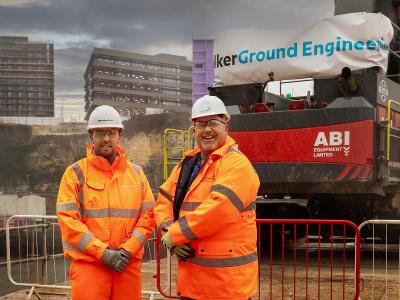No bridge too far for footbridge developer
21 March, 2024

The LATEST milestone in the construction of the new River Wear footbridge has proven a world-first for the civil engineering community.
Civil engineering specialist, VolkerStevin, has designed and delivered a first-of-its-kind piling solution for the high-level New Wear Footbridge in Sunderland.
A series of piles are required for the bridge foundations. This involves drilling a large void down to rock level and replacing the earth removed with reinforced concrete.
However, due to the location of the bridge's north pier beside the River Wear, and river working restrictions, the team were unable to create the required access for a traditional piling rig, leading to an entirely new solution being developed.
Working in collaboration with its sister business, VolkerGround Engineering, the team created a bespoke cantilever piling solution, overcoming the access, design, and environmental challenges. This approach not only allowed a crucial part of the project to be finished, but also serves as a benchmark for future projects.
Mark Denham, project director, said: "At VolkerStevin we're no strangers to overcoming complex challenges and the innovative cantilevered piling frame was a crucial part required for the success of this project. The development of this solution was made possible through a collaborative approach involving our in-house temporary works team and piling specialists, key supply chain partners and our client.
The absence of similar existing solutions prompted extensive research across different sectors. We rigorously evaluated potential solutions based on health and safety, environmental impact, and buildability, leading to the development of this preferred solution from concept to detailed design."
The new cantilevered piling frame enabled the piling rig to move out from ground level at the bottom of an access slope, reaching the permanent pile location. Additional support guides were required to support the frame at the mid and end points due to the horizontal distance of the piles from the bottom of the slope. These supports were designed with flexibility and motion in mind, as needed while piling operations took place.
The frame design allowed for a set of six piles at each location to be completed, then relocated after each set. A waste tray was placed to the rear of the piling rig so that any waste did not enter the river and could be recovered for safe disposal.
Piling to the south pier also required an innovative approach to avoid putting pressure on a historical wall. The team designed two rows of temporary piles, with the front row in bearing weight and the rear row pulling back. From here, it was possible to build a strong foundation to support the piling frame and install the permanent piles without impacting the historic wall.
The same frame was used for piling operations on both the north and south piers. The team assembled, adjusted and tested the frame on-site.
Councillor Graeme Miller, leader of Sunderland City Council, said: "We're delighted to be moving forward with works on the new Wear footbridge.
"The innovative work VolkerStevin has done so far is fantastic and will be pivotal to helping us execute our Riverside Sunderland masterplan. The change the footbridge will make to the city will be incredible, becoming a true centrepiece of the city."
Once complete, the new footbridge will be 10m wide, 30m high and over 250m long, comprising reinforced concrete piers, steel box girder superstructure and a precast concrete deck. Other features include steel parapets, lighting, street furniture and various architectural features. It will improve connectivity for both pedestrians and cyclists between the city centre and the Sheepfolds area.
Check out this video




